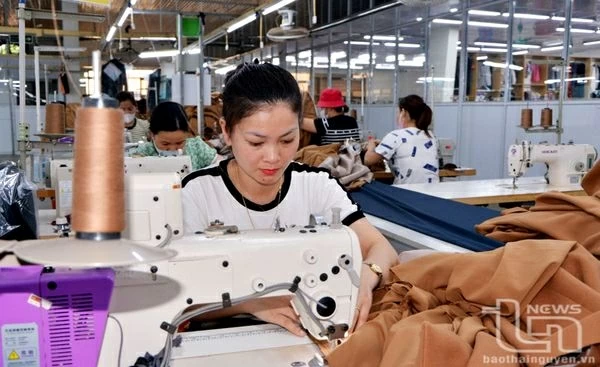Garment export enterprises strive to accelerate
For many months, garment export production activities at TDT Investment and Development Joint Stock Company (headquartered in Phu Binh district) have been very busy. Up to now, the unit has established enough orders until the end of 2024. According to the enterprise representative, the orders are mainly exported to the US, Korea, Canada... and increased by about 30% compared to the same period last year. This is a positive signal to help enterprises gradually overcome difficulties and soon complete the year plan.
To meet the number of orders and keep up with the schedule, currently, 2/2 of TDT's factories in Phu Binh and Dai Tu districts are operating at 85-90% of their design capacity; the unit has also recruited 200 new workers. Similarly, TNG Investment and Trading Joint Stock Company, Thanh Hung Garment Joint Stock Company... have also signed orders until the end of the third and fourth quarters of 2024. Mr. Nguyen Viet Hanh, Director of Thanh Hung Garment Joint Stock Company, excitedly said: Compared to the same period last year, export garment orders increased by 20-30%, and the order value also increased by 5-10%. Currently, we have invested in a number of additional sewing lines and modern equipment to meet production needs, striving to reach the 2024 revenue (equivalent to 4.5 million USD) ahead of schedule.
According to the functional sector, from the beginning of the year until now, the province's garment output is estimated at 48.9 million products, up 21% over the same period. The garment export market is on the path of recovery and improvement. Specifically, traditional export markets such as the US, Europe... are actively controlling inflation. The remaining warehouses of fashion brands have therefore also decreased, increasing purchasing power. In addition, Vietnamese garment enterprises, including Thai Nguyen, are also receiving a shift in orders from other countries due to the exchange rate of the Vietnamese Dong (VND) decreasing by 5% compared to the US dollar (USD) since the beginning of the year, while the currencies of competing countries are almost unchanged compared to the USD...
 |
Seizing the opportunity, garment enterprises have made efforts and focused on restructuring the market. Along with maintaining traditional markets (such as the US, Europe), many enterprises have expanded their search for export markets to Russia, Korea and some Asian countries. Some garment enterprises have begun to restructure and invest in technology, green transformation to meet the requirements of buyers, improve competitiveness; convert processing methods to other methods. A typical example is TNG Investment and Trading Joint Stock Company. Mr. Nguyen Van Thoi, Chairman of the Board of Directors of TNG Investment and Trading Joint Stock Company, said: Currently, TNG has implemented transparency in all information on environment - Society - Governance (ESG) according to the Global Reporting Initiative standards and is currently meeting 17 sustainable development goals. The entire factory and office of TNG textile and garment are aiming for green standards such as LOTUS or LEED.
 |
In addition to the achieved results, according to experts, garment enterprises are still facing some difficulties and challenges. That is, textile orders have recovered but the processing unit price is still very low, the order capacity is small but the delivery time requirement is shortened. The costs of raw materials and logistics are still too high in the context of Vietnam gradually losing its advantage in cheap labor.
In the above context, experts recommend that garment enterprises focus on and promote the building of their own product brands, replacing exported products that still have to bear the names of other major brands in the world; focus on digital transformation, towards smart production; take advantage of the strategic advantages of the development of the Vietnamese textile and footwear industry until 2030, with a vision to 2035 approved by the Government and the opportunities brought by FTAs.














